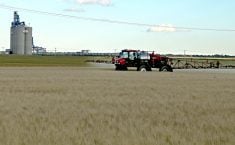Taking NIR from the lab to the field and now to portability put producers in control of their products
Moisture is one of the most significant controllable variables for grain producers. It matters when you’re growing, harvesting, buying, selling, processing, preparing and shipping. Moisture impacts profitability at every stage.
The latest grain moisture measuring technology available to farmers is near-infrared, or NIR.
NIR offers significant benefits compared to traditional methods such as Karl Fischer (KF) or Loss On Drying (LOD). According to a news release from Kett, a firm that’s been manufacturing moisture meters for 75 years, grain farmers can benefit from NIR technology in three ways,
- Greater human efficiency — A considerable amount of staff time is tied up conducting (KF) or (LOD) tests.
The KF test involves adding chemical reagents to separate water from remaining product. The removed water is compared with the initial mass or volume. Chemical reagents are used so skilled personnel must determine the initial parameters and confirm that the system is properly calibrated. Disposal of the waste products can be costly and time consuming.
The LOD test measures the total material weight change after drying. It typically requires a sample to be prepared and brought to a lab. The test is too slow if immediate measurements are needed.
NIR technology enables the user to get accurate measurements instantly. It’s simple enough that anyone can use it with minimal training. Fewer than 10 samples are generally needed for a valid calibration. Once calibrated the moisture level in a product is determined immediately.
Kett’s KJT130 handheld instant moisture meter lets the operator aim the instrument at the product and the moisture content is instantly shown on a digital display. Results are accurate to .01 percent in a 0-100 percent range. It’s operated with menu commands.
The unit is the size of a camcorder, designed for frequent spot checks on stationary and moving process line products. Data may be stored in the instrument, downloaded continuously or manually recorded.
- Improved quality control — Quality can be compromised if producers lack the correct percent of moisture in the product, resulting in either product loss or reduced shelf life. The speed and accuracy with which grain handlers obtain NIR results enables them to conduct more tests within a given period. Managers can achieve tighter control of product quality. Because the process is non-destructive, samples remain unaltered so they can be used for additional tests later.
Kett manager John Bogart said, “Since no direct contact or sample alteration is required with NIR moisture meters, particle-size variation and unusual textures are not an issue. This can be important when used with a range of feedstocks, formulations or end products in different settings.”

“We’ve been manufacturing moisture meters for over 75 years,” Bogart said. “Our plan to get instruments into Canadian farmers hands is to sell direct, from our office or the website.”
He said the portable units start at about $10,000 and range up to $70,000. Portable units can be fitted to combines.
Tecno Cientifica from Argentina has been producing NIR analysis equipment for 20 years and offers a mobile unit for combines. The company provides kits for most machines. It can also be removed and used for grain dryers, cleaners and elevation or processing lines when not on a combine. It provides moisture as well as protein for wheat and barley; for soybeans it adds fat; and with corn starch can also be measured.


















